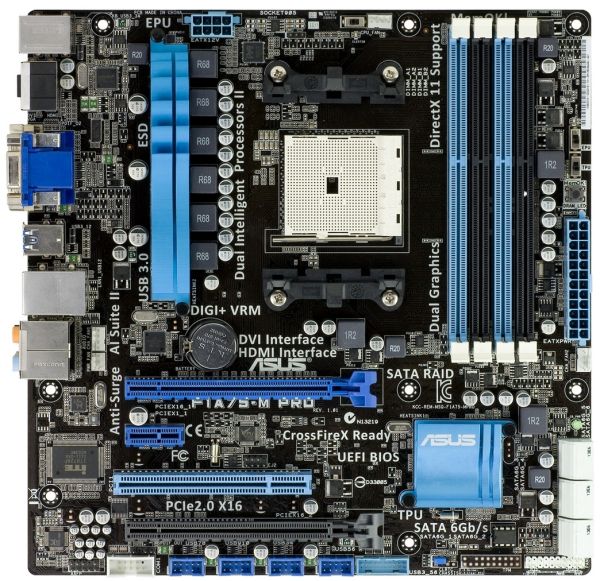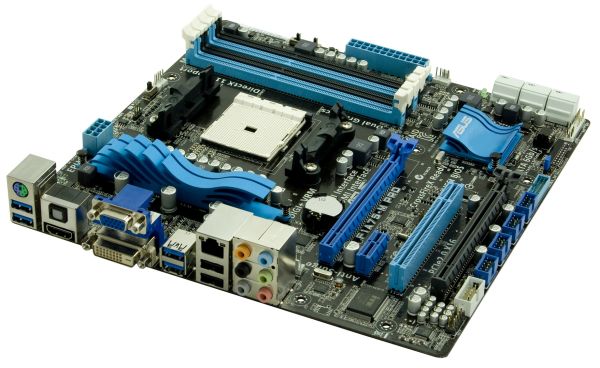ASUS F1A75-M Pro Review - Micro-ATX Llano at $110
by Brendan van Varik on January 22, 2012 2:00 AM EST- Posted in
- Motherboards
- Asus
- Llano
Llano is still selling strong for AMD, as shown by the relatively recent reports of representing a major aspect of their CPU profit margins. Building on our Llano and A75 review base, ASUS gave us the opportunity to look at their F1A75-M Pro motherboard - e-tailing at the time of writing for around $110. Here at AnandTech we have reviewed other offerings from ASUS in A75, in full ATX from the F1A75-V Pro, and the mini-ITX F1A75-I Deluxe. This time, it's the turn of micro-ATX.
If we do a direct comparison between the three ASUS boards, we see:
| ASUS F1A75-V Pro | ASUS F1A75-M Pro | ASUS F1A75-I Deluxe | |
| Size | ATX | Micro ATX | Mini-ITX |
| Price (01/16) | $120 | $110 | $140 |
| Power Phase | 6+2 | 4+2 | 4+2 |
| Memory | 4 x DDR3 | 4 x DDR3 | 2 x DDR3 |
| PCIe |
1 x PCIe x16 1 x PCIe x4 2 x PCIe x1 3 x PCI |
1 x PCIe x16 1 x PCIe x4 1 x PCIe x1 1 x PCI |
1 x PCIe x16 |
| CrossfireX/SLI | APU + Normal CrossfireX | APU + Normal CrossfireX | APU CrossfireX |
| Audio | Realtek ALC892 | Realtek ALC892 | Realtek ALC892 |
| LAN | Realtek 8111E | Realtek 8111E | Realtek 8111E |
| SATA 6 Gbps | 7 + 1 eSATA | 6 | 4 + 1 eSATA |
| USB 3.0 | 4 + 2 | 4 + 2 | 2 + 2 |
| USB 2.0 | 2 + 8 | 2 + 8 | 4 + 2 |
Size obviously has advantages - a full size ATX board has room for better power delivery, a broader range of PCI/PCIe options, and scope for more controllers (e.g. SATA 6 Gbps). In the micro-ATX smaller form factor, most of the features are still there - ALC892 audio, gigabit Ethernet, at least 6 SATA 6 Gbps ports, 4 USB 3.0 ports, and opportunities for up to 16 GB of memory with 4 GB DIMMs. It's only on the mini-ITX we lose some functionality - only 4 SATA 6 Gbps on board (plus one eSATA), room for only 8 GB of memory, and no PCI/PCIe x1 slots. But the advantage of a small board is primarily its size, for a sleeker and slimmer system. The question then becomes whether the F1A75-M Pro, the micro-ATX board, is worth $10 less than the ATX board as a whole.
Visual Inspection
The black and blue livery of ASUS systems of late has been the stalwart of their consumer level line-up, and appears again here on the F1A75-M Pro, with a little white for the SATA ports. The wavy design with pretty substantial fins for both the VRM and South Bridge heatsink could be considered more style rather than substance, but due to the motherboard supporting 100 W processors, the VRM heatsink may be required to shift a lot of heat and it should be sufficient to cope due to ASUS’ careful attention to detail in their design.
We also have EPU and TPU (Energy Processing Unit and Turbo Processing Unit) chips present. These two have separate roles - to reduce the carbon footprint of your computer with the EPU processor, and the TPU processor is there to diagnose the system for an optimal overclock when either the TPU switch is used or the BIOS option is enabled.
Working our way around the board, you will notice that there are four fan connections available. The CPU fan is located above the socket, and in the lower left half of the socket area there are two more fan connections available - one of them is a PWM based chassis fan header whilst the other is the PWR header which is 3-pin. The final header can be found on the right-hand-side of the motherboard just below the 24-pin power and it is a chassis fan which is also PWM based. Unfortunately, you do not have option to control the two chassis fans independently in the BIOS nor in the software.
Looking at the expansion options on this motherboard; there are two PCIe x16 slots which run at x16/x4 when in a CrossFireX setup, resulting in limited bandwidth of the second GPU, as detailed in our previous A75 reviews. Also on board is a PCIe x1 as well as a single PCI slot.
As SATA 6 Gbps is native on this platform, there are no SATA 3 Gbps ports to be found. There are six ports in total and they support RAID with the option to use RAID 0, RAID 1, RAID 10 or JBOD. These are all in white on the bottom right of the board.
On the back panel of the board, from left to right, we have a combined PS2 port, two USB 3.0 ports, a HDMI output, an optical SPDIF output, as well as VGA and DVI-D ports for your display outputs. Further along, there are two more USB 3.0 ports and two USB 2.0 ports with a gigabit LAN port above. Lastly, there are the six ports for your various sound inputs and outputs.














32 Comments
View All Comments
cjs150 - Monday, January 23, 2012 - link
I have found Anandtechs reviews of the IGP to be very helpful, and I agree for boards which could be for an HTPC it would be a good idea to at least link back to the original IGP review.I cannot remember seeing a detailed review of on-board sound from Anand - other than whether it could be channeled through the HDMI port. Great suggestion - ANAND time to pick up on this one.
Whilst there is no need for U-ATX board for an HTPC build I keep looking at a Wesena case and thinking it could look very good
Also ANAND any chance of a review of the Pico-ITX announced by both Zotac and VIA, bit worried about the fans in them, but they could be a really stunning mini-HTPC (although would need to use USB for TV card which is not ideal) also maybe the Zotac AD04 announced at CES
geniekid - Monday, January 23, 2012 - link
FWIW, I use one of these in my HTPC and I haven't had any problems so far.ASUSTechMKT - Monday, January 23, 2012 - link
Kudos and glad to read everything has been smooth!edward2 - Monday, January 23, 2012 - link
PLEASE everyone who wants to buy this MB read this carefully!I bought an Asus F1A75-V Pro MB, before that I've read a lot of review about it and even the asus website specification etc. None of these were mentioning the following:
****These ASUS MBs are not supporting HDMI and DVI-D simultaneous use****
So the whole FM1 platform is completely useless for an HTPC and for a normal setup like HDTV + DVI monitor.
Death666Angel - Monday, January 23, 2012 - link
Then you didn't read very carefully:http://www.asus.com/Motherboards/AMD_Socket_FM1/F1...
"Note *1: HDMI and DVI-D cannot work simultaneously."
I don't really see how this affects the standard HTPC environment though, as I only know people with one TV in their living room. But if you do need that, you have to look elsewhere. :-)
ASUSTechMKT - Monday, January 23, 2012 - link
you can run HDMI/DVI out as the same time as VGA but dual digital output is not supported.Should you want this functionality you can enabled the multi display option within the UEFI and add an additional GPU like a 6500 or 6600 series GPU and then have dual digital output support.
As the user additionally notes this is listed on our support page.
ASUSTechMKT - Monday, January 23, 2012 - link
That is great thanks for the support and glad to read you have had a smooth and solid experience. Do not forgot to check out USB3 Boost which should be posted to your support site shortly or download it from our USB3 Boost landing page directly.rodrigo.dk - Monday, January 23, 2012 - link
I bought one of these in december, and WakeOnLan didn't worked at all. With recent updates it is working ;)D3xx - Monday, January 23, 2012 - link
How would this board and chip compare with an i5 2500 in Z68? Assume both are using 5850 graphics.fluxtatic - Tuesday, January 24, 2012 - link
Are you trolling?On topic, I've got to agree with some of the above - if the graph was labeled correctly, how are you going to publish power consumption numbers on a Llano board with 2 5850s (and then call it typical)? Especially given that half the appeal of Llano is that you don't need discrete graphics at all in most cases?
I can see 1 discrete card for the HTPC market, but likely a low-noise model - lower-end mainstream with either a massive, slow fan, or a colossal heat sink and no fan at all.